Metaphysical Art Gallery (形而上畫廊) presents Never Say Goodbye (不要說再見), a retrospective of the late modern artist Wu Hao (吳昊). As a prolific painter and printmaker, he was an iconic figure of the Post World War II art scene. In 1956, Wu co-founded the pioneering art collective Ton Fan Group (東方畫會) together with seven other artists who studied under the Chinese painter Lee Chun-Shang (李仲生). The group searched for modernity in tradition by exploring the language of abstract painting. Wu’s retrospective features 22 pieces that offer a panoramic view of his career from 1975 to 2011. While he is best known for his luscious prints inspired by Taiwanese folk art, Wu tackled a number of artistic ideas, including multi-perspective flatness and the unsophisticated tastes of popular art, writes the gallery. “Wu transformed popular symbols and images into modern structures and styles, expressing… tender yet wild, unrestrained qualities.” In 2010, Wu, 78, continued to explore new ideas, including compositions that involved outdoor subjects and themes. In honor of Wu Hao, the gallery will also host a charity bazaar featuring limited edition prints. For more information please contact the gallery.
■ Metaphysical Art Gallery (形而上畫廊), 7F, 219, Dunhua S Rd Sec 1, Taipei City (台北市敦化南路一段219號7樓), tel: (02) 2771-3236. Open Tuesdays to Sundays from 11am to 6:30pm
■ Until June 30
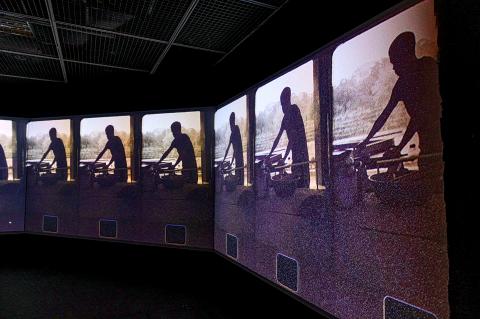
Photo Courtesy of Museum of Contemporary Art Taipei
Wang Ya-hui (王雅慧) is a Taipei-based artist who creates photographs, videos and installations that reflect on the quotidian. Wang challenges the boundaries of visual perception by exploring opposites such as emptiness and fullness, interior and exterior, and transforming elements of daily life into new visual networks, which she refers to as constellations. Her solo exhibition at Eslite Gallery (誠品畫廊), A Brief History of Time (時間簡史), features 18 works created in the past 15 years that offer insight into the artist’s contemplations of nature, time and life. The gallery compares the artist to an astronomer who studies and philosophizes about the qualities and relationships that exist in nature. Several of her earlier works, such as the video installation Two Billion Light Years of Solitude and The Tropical Work: Snowman, have been modified for this show. Wanderer’s Clock is a new series about changing configurations that evolve with time. A catalogue about Wang’s work and writings will also be available at the gallery.
■ Eslite Gallery (誠品畫廊), 5F, 11 Songgao Rd, Taipei City (台北市松高路11號5樓), tel: (02) 8789-3388. Open Tuesdays to Sundays from 11am to 7pm
■ Until July 21
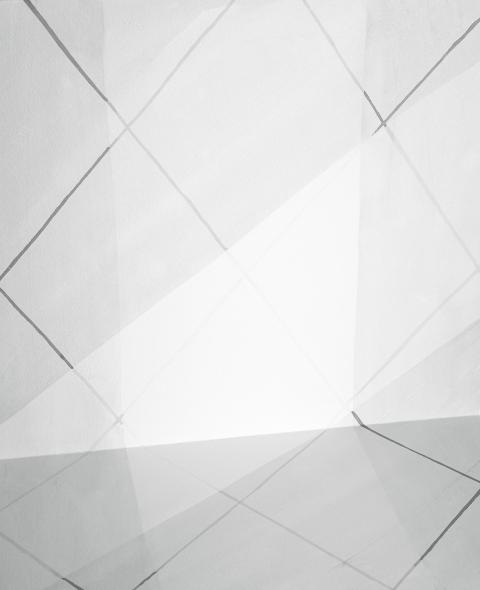
Photo Courtesy of Eslite Gallery
Shan Hai Jing (山海經) is a 360 degree video installation created by artists Lai Shi-chao (賴士超) and Chiu Chih-chun (邱智群). Presented at the National Taiwan Museum of Fine Arts (國立台灣美術館), the work proposes a contemporary interpretation of the literary classic Shan Hai Jing, also known as The Classic of Mountains and Seas. The book is a highly imaginative account of a Chinese mythological world that is said to be written by numerous authors between China’s Warring States period and the Han Dynasty. According to the museum’s preface, the book describes a spiritual vision of Asian ancestors that embodies an ancient view of human society and the world. “As their descendants, how are we impacted by [Shan Hai Jing’s] profound structure and symbolism?” Lai and Chiu reflect upon this question by returning to fundamental philosophical inquiries, grappling with history, identity and the greater universe. As Taiwanese, the artists address their disorienting sense of ethnic identity infused with Chinese cultural aesthetics through their reflections on ancient storytelling.
■ National Taiwan Museum of Fine Arts (國立台灣美術館), 2, Wuquan W Rd Sec 1, Taichung City (台中市五權西路一段2號), tel: (04) 2373-3552. Open Tuesdays to Fridays from 9am to 5pm, Saturdays and Sundays from 9am to 6pm
■ Until June 23
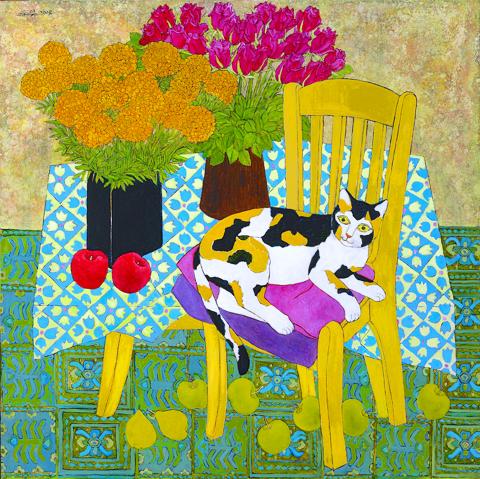
Photo Courtesy of Metaphysical Art Gallery
Where Have All The Flowers Gone (查無此人─小花計畫展) is an exhibition about memory, song and sensibilities. The project began five years ago after the demolition and relocation of Gonghe Military Village (共和新村) in Pingtung County (屏東). Curator Joe Fang (方序中) examines the idea of a home that can never be returned to, which fosters a shared sense of loss among past residents. With the passing of time, we have slowly forgotten the things we used to cherish, says Fang. The show is inspired by the ephemerality of memory and its associations to music. Artists and musicians have teamed up to present collaborative projects using illumination, interactive and interdisciplinary media. Incomplete Memories (臺灣是好所在) is a panoramic video installation created by musicians Lim Giong (林強) and Point, and artists Huang Pang-chuan (黃邦銓) and Tsai Meng-chang (蔡孟閶). The work reflects on Taiwanese folk culture, language and music that delivers a subjective understanding of life and rhythm. The Hidden Memories (隱形的紀念) is a two-channel video installation created by Taiwanese singer-songwriter Ashin (阿信) and Japanese music group Maywa Denki (明和電機). The work speaks of love and remembrance and the passing of time.
■ Museum of Contemporary Art (台北當代藝術館, MOCA, Taipei), 39, Changan W Rd, Taipei City (台北市長安西路39號), tel: (02) 2559-6615. Open Tuesdays to Sundays from 10am to 6pm
■ Until July 7
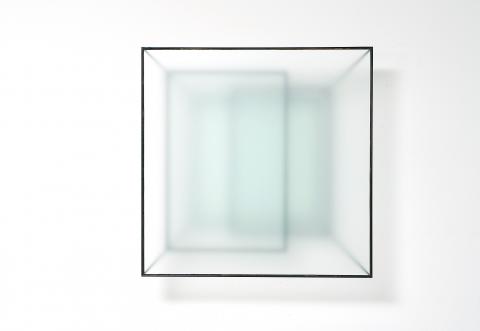
Photo Courtesy of Bluerider Art
Reinoud Oudshoorn is an Amsterdam-based artist who creates minimalist sculptures that explore the dynamics between illusions of flatness and three-dimensional space. Using mathematical calculations, the artist begins his sculptural process by drawing lines, then planes, which gradually build into three-dimensional spaces made with iron and frosted glass. For the artist, frosted glass is “a symbol of the contemplative, metaphysical and mysterious,” that which gives an impression of muffled silence of mist that he associates with the landscape of his homeland. Oudshoorn’s solo exhibition, Vanishing Point, at Bluerider Art (藍騎士藝術空間), features a selection of works that embody his philosophy that “sculpture must generate more space than it consumes.” Using limited materials, the artist offers an experience of “the totality of space through a relatively small object,” writes the gallery. The artist’s artistic inspirations originate from his observations of nature and architectural shapes. He takes abstract structures and surfaces and accentuates qualities that reveal the relationship between nature and infinity.
■ Bluerider Art (藍騎士藝術空間), 9F, 25-1, Renai Rd Sec 4, Taipei City (台北市仁愛路四段25-1號9樓), tel: (02) 2752-2238. Open Tuesdays to Saturdays from 9am to 6pm.
■ Until June 29
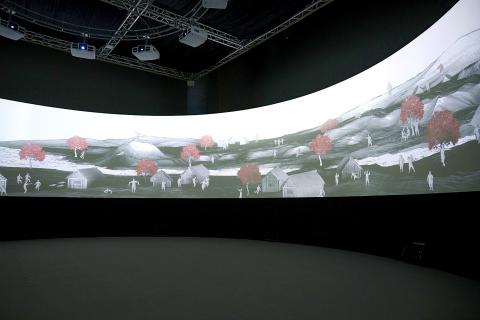
Photo Courtesy of National Taiwan Museum of Fine Arts
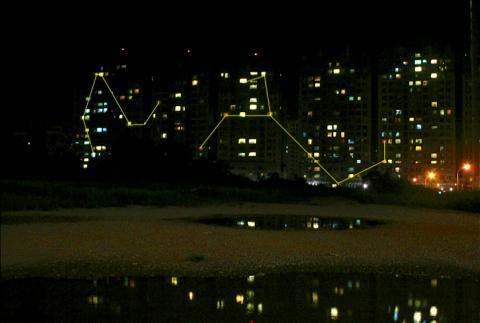
Photo Courtesy of Eslite Gallery

June 9 to June 15 A photo of two men riding trendy high-wheel Penny-Farthing bicycles past a Qing Dynasty gate aptly captures the essence of Taipei in 1897 — a newly colonized city on the cusp of great change. The Japanese began making significant modifications to the cityscape in 1899, tearing down Qing-era structures, widening boulevards and installing Western-style infrastructure and buildings. The photographer, Minosuke Imamura, only spent a year in Taiwan as a cartographer for the governor-general’s office, but he left behind a treasure trove of 130 images showing life at the onset of Japanese rule, spanning July 1897 to

One of the most important gripes that Taiwanese have about the Democratic Progressive Party (DPP) is that it has failed to deliver concretely on higher wages, housing prices and other bread-and-butter issues. The parallel complaint is that the DPP cares only about glamor issues, such as removing markers of Chinese Nationalist Party (KMT) colonialism by renaming them, or what the KMT codes as “de-Sinification.” Once again, as a critical election looms, the DPP is presenting evidence for that charge. The KMT was quick to jump on the recent proposal of the Ministry of the Interior (MOI) to rename roads that symbolize

On the evening of June 1, Control Yuan Secretary-General Lee Chun-yi (李俊俋) apologized and resigned in disgrace. His crime was instructing his driver to use a Control Yuan vehicle to transport his dog to a pet grooming salon. The Control Yuan is the government branch that investigates, audits and impeaches government officials for, among other things, misuse of government funds, so his misuse of a government vehicle was highly inappropriate. If this story were told to anyone living in the golden era of swaggering gangsters, flashy nouveau riche businessmen, and corrupt “black gold” politics of the 1980s and 1990s, they would have laughed.

In an interview posted online by United Daily News (UDN) on May 26, current Chinese Nationalist Party (KMT) Chairman Eric Chu (朱立倫) was asked about Taichung Mayor Lu Shiow-yen (盧秀燕) replacing him as party chair. Though not yet officially running, by the customs of Taiwan politics, Lu has been signalling she is both running for party chair and to be the party’s 2028 presidential candidate. She told an international media outlet that she was considering a run. She also gave a speech in Keelung on national priorities and foreign affairs. For details, see the May 23 edition of this column,